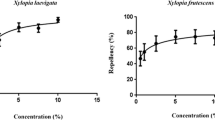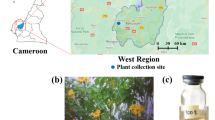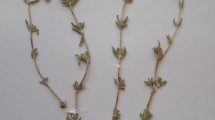Abstract
Plant extracts, particularly plant oils, had been used and were still in use as repellents against mosquitoes. Some of them (e.g., lavender, geraniol, and citriodiol) have been notified by the European Commission as active substances to be used in repellents, which are categorized as biocides in product type 19. In the literature, it is known that these substances must be added to repellent products in high concentrations (e.g., 20 % and more) in order to reach repellent efficacy. Therefore, the question arose whether they also have repellent effects if they were added as fragrances at low concentrations of 0.25 or 1 % to registered active substances in order to obtain a better scent of this product. In the present study, the repellent effects of 0.25 and 1 % additions of 15 plant extracts (citronellol, cinerol, citral, menthol, linalyl acetate, Eucalyptus citriodora, Eucalyptus globulus, Cymbopogon nardus, lilac, sandalwood, Vitex agnus castus, rosewood, lavender, geraniol, and paramenthan diol) when exposed on skin to hungry Aedes aegypti mosquitoes. These experiments showed that there was no repellent effect in any of these compounds even when the test was done already 10 min after distributing any of the compounds onto the hands of volunteers. These experiments have proven that these 15 compounds do not produce repellent effects as long as they are used in low concentrations of 0.25 or 1 % as fragrances to ameliorate the odor of a notified repellent that is brought onto the skin.
Similar content being viewed by others
References
Amer A, Mehlhorn H (2006a) Repellency effect of forty-one essential oils against Aedes, Anopheles and Culex mosquitoes. Parasitol Res 99:478–490
Amer A, Mehlhorn H (2006b) Persistency of larvadicidal effects of plant oils under different storage conditions. Parasitol Res 99:473–477
Amer A, Mehlhorn H (2006c) The sensilla of Aedes and Anopheles mosquitoes and their importance in repellency. Parasitol Res 99:491–499
Amer A, Mehlhorn H (2006d) Larvicidal effects of various essential oils against Aedes, Anopheles and Culex larvae (Diptera, Culicidae). Parasitol Res 99:466–472
Aspöck H (ed) (2010) Arthropods as vectors of agents of diseases. Denisia 30, Landesmuseum Austria, Vienna
Bingen H (1170) Physica. New edition (1974). Müller Wiss Buchgesellnschaft, Salzburg (in German)
Büchel KH (1970) Insekten-Repellents. In: Wegler H (ed) Chemie der Pflanzenschutz- und Schädlingsbekämpfungsmittel. Springer, New York, pp 487–496
Cox FEG, Wakelin D, Despommier DD (eds) (2005) Parasitology, vol 5, Topley Wilson's microbiology and microbial infections. Hodder Arnold, London
Faulde M (2001) Repellentien. In: Korting HC, Sterry W (eds) Therapeutische Verfahren in der Dermatologie. Dermatika und Kosmetika. Blackwell, Berlin, pp 727–741
Frosch PJ, Johansen JD, Menne T et al (2002) Further important sensitizers in patients sensitive to fragrances. Contact Dermatitis 47:279–287
Hagvall L, Karlberg AT, Christensson JB (2013) Finding the optimal patch test material and test concentration to detect contact allergy to geraniol. Contact Dermatitis 68:224–231
Lalko J, Api AM (2005) Investigation of the dermal sensitization potential of various essential oils in the local lymph node assay. Food Chem Toxicol 44:739–746
Mehlhorn H (ed) (2008) Encyclopedia of parasitology, 3rd edn. Springer, Heidelberg
Nentwig G (2003) Use of repellents as prophylactic agents. Parasitol Res 90:S40–S48
Shutty B, Swender D, Chernin L et al (2013) Insect repellents and contact urticaria: different response to DEET and picaridin. Cutis 91:280–282
Trattner A, David M, Lazarov A (2009) Occupational contact dermatitis due to essential oils. Contact Dermatitis 58:282–284
Uter W, Schmidt E, Geier J et al (2010) Contact allergy to essential oils: current patch test results (2000–2008) from information network of Departments of Dermatology (IVDK). Contact Allergy 63:277–283
Uter W, Johansen JD, Börje A et al (2013) Categorization of fragrance contact allergens for prioritization of preventive measures: clinical and experimental data and consideration of structure–activity and relationships. Contact Dermatitis 69(4):196–230
Author information
Authors and Affiliations
Corresponding author
Rights and permissions
About this article
Cite this article
Semmler, M., Abdel-Ghaffar, F., Schmidt, J. et al. Evaluation of biological and chemical insect repellents and their potential adverse effects. Parasitol Res 113, 185–188 (2014). https://doi.org/10.1007/s00436-013-3641-7
Received:
Accepted:
Published:
Issue Date:
DOI: https://doi.org/10.1007/s00436-013-3641-7




